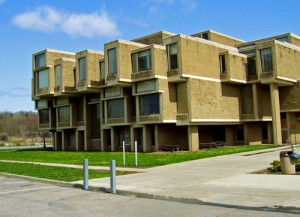
The New York Times article about the Paul Rudolph county government center in Goshen, N.Y. that is threatened with demolition, has fueled a keen (and since this is 2012, a rather rude) debate. Many conservationists’ attitude to old buildings is that they should be treated like art, that is, carefully preserved. The problem is that buildings, unlike paintings, are fixed in place. Art that falls out of favor doesn’t have to be destroyed, it can simply be taken out of the front room and put in the back, or in a museum’s open storage, or ultimately in a suburban warehouse. It is available to be pulled out, if the need arises, that is if tastes change. One thinks of French pompier art of the late 19th century. It was popular—everything starts by being popular with whoever paid for it—then fell out of favor, then was resurrected (see the Musée d’Orsay). Musical compositions can be played, or not played, or rediscovered and played anew. But a building is a part of one’s world, like it or not. It must be lived in and with. One argument is to err on the side of conservation, assuming that at some future time someone will see something that eludes us. Certainly was the case with Frank Furness, and with Rudolph today. But maintenance and change are an essential part of a building’s life. A building that is unloved will have a hard time of it; it will not be taken care of, and it will be insensitively altered. Maybe Rudolph’s building shouldn’t be demolished, but should it be conserved?

I was excited to have just discovered your blog. I left my teaching position at Goshen High School in 1995 and enrolled in the architecture program at the University of Tennessee. The assistant principle gave me a parting gift–it was your book THE MOST BEAUTIFUL HOUSE IN THE WORLD. I read the book and became a big fan of yours and have since read many others. I used to drive by the Rudolf building daily and although I liked the building it did seam rather out of place and between it an the enormous parking lot it did take away from the charming village of Goshen. If I felt confident that the site would be properly developed I don’t think I would have a problem if it came down. What I fear is what would replace it.
Since entering and using the lightless, heavy building (I have only been to the jury selection area and the DMV) is most similar to spelunking, I propose that it be converted to its truest use: all fixtures and windows stripped out, the whole thing mounded over with an accessible green roof, and the resulting lower portion opened as a new tourist attraction– Goshen Caverns.
I think there is another difference between a painting and a building that is worth mentioning: An original painting is something physically made by a particular person, so the original is connected with that person in a way that some people care about. A building is rarely built by the particular person with whom it is identified. Rather like music, it is usually brought to life by one or more other people. Therefore, the building can be destroyed and recreated later, or pieces of the design can be used in later works, or the original or as-builts can be retained for education. Something is lost, particularly if the designer was intimately connected with the construction, but not nearly as much as when an original oil painting is lost and the only thing remaining is a copy or print.
This is an insightful comment. Although architects pretend that their building are expressive works of art, “Life always has the last word,” as Le Corbusier ruefully observed. People use and appropriate (and alter) buildings in ways that would be unthinkable in the context of a work of art. And buildings, as Stewart Brand wisely observed, learn from–and adapt to–the experience.